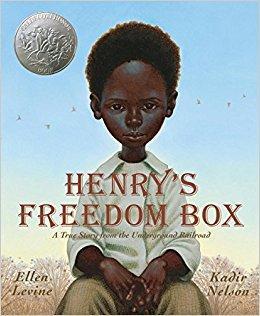
Henry's Freedom Box
Read Aloud Book: Henry's Freedom Box
Story: Ellen Levine
Illustration: Kadir Nelson
ISBN-13: 978-0439928786
C3 Framework Key term: Human rights: Rights or freedoms possessed by all people by virtue of their being human.
Synopsis
When he was a child, Henry was separated from his family when his master gave him to his son. Henry worked at a tobacco farm in Virginia under a harsh master. However, he considered himself lucky, because his wife and children lived with him. When his wife and children were sold without a warning to a plantation owner in North Carolina, Henry knew he will never see them again. In 1849, with the help of a doctor who believed that slavery was wrong, Henry shipped himself in a crate to Philadelphia, where he started a new life as a free man.
Discussion
Expand: This book tells the story of a real person, Henry "Box" Brown (1816 –1897). After his successful escape, Henry faced a dilemma – listen to the advice of abolitionist leaders and keep his story confidential, to protect himself from being caught by slave catchers, or make his story public and inspire other others to dare to escape. Ask: What would you advise him to do? Why? Say: Brown presented about his story at the New England Anti-Slavery Society Convention in Boston. He also toured the region and spoke about his life as a slave and his escape. His story, as he told it to a book publisher, was published in print. Ask: Why slaves’ testimony was important to antislavery actions?
Ethics Connection
Contextualize: One of the many troubling realities of slavery was that marriage was a civil right available only to free people. Even after giving their slaves permission to marry, slave owners had the right to separate husbands, wives, and children at any time. Despite constant fear of separation, family values were important to slaves, and they saw family relationships as important to their survival. The right of former slaves to marry did not automatically take effect after the Civil War. The Civil Rights Act of 1866 aimed to ensure the equal right of all US citizens to make and enforce contracts (including marriage contracts), sue and be sued, give evidence in court, and inherit, purchase, lease, sell, hold, and convey real and personal property. The Congress first enacted the Civil Rights Act in 1865, but President Andrew Johnson vetoed it. In 1866, Congress passed it again, but Andrew Johnson, again, vetoed it. It took a two-thirds majority in both the House and the Senate to override the president’s veto. Introduce group activity: The constitution grants the president the power to refuse to sign the legislation. In groups, discuss the pros and cons of such power. How can it be used to protect people? How can it be used to deny human rights?
Fun Activity
Say: Access the list of presidential vetoes on the United States House of Representatives’ website. Create a graph showing statistical analysis of data from this table. For example, you can compare the number of total vetoes to the number of vetoes overridden by Congress. You can present data across all presidents, by time periods, by grouping presidential terms, or by grouping Congressional terms. Make meaning: What have you learned from this graph?